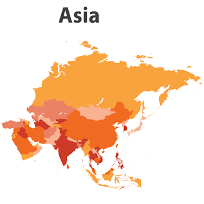Fidelity Asian Values plc (LON:FAS) Fund Manager Nitin Bajaj caught up with DirectorsTalk for an exclusive interview to discuss investment philosophy & approach, investment opportunities in different parts of Asia and in growth stocks, increased exposure to the financial sector & decreased exposure to the technology sector, the medium term demand impact from high oil and commodity prices and the process he goes through before adding high conviction holdings to the portfolio.
Q1: Just as a way of introduction, could you give us a brief overview of Fidelity Asian Values, its investment philosophy, your investment approach and what you believe makes it different?
A1: I don’t think I can tell you what makes it different, I can only tell you what I do. My investment philosophy actually isn’t very complicated, it’s very similar to what you would do in your personal life.
So, if you’re in the UK and you’re trying to buy a business for yourself, what do you want to do? First and foremost, you want to buy a good business, and by a good business I mean a business which makes a product which is in demand by the customer and the business can make a decent return on capital while doing their business.
So, first and foremost you want to buy a good business, second you want to hire the right people to run it for you and third you want to buy it at a price that leaves enough margin of safety for bad judgement, mistakes etc.
I just try to do that in the stock market, buy good businesses run by people that are competent and honest and buy them at a price that leaves enough margin of safety.
Q2: Although you’re not a thematic or top down investor, are there areas of the market within different parts of Asia where you are finding more investment opportunities? If that is the case, can you give us some examples?
A2: It’s always the case that the market goes in cycles and sometimes investors are focussed on certain parts of the market and at other times focussed on other parts of the market.
So, at the moment the places that I find the most ignored are first and foremost Chinese companies listed in Hong Kong and I see some incredible opportunities in Chinese companies listed in Hong Kong. You can buy really long duration businesses that have been around for 30/40/50 years with no risk of disruption, with net cash balance sheets on 4/5 times earnings with dividend yields of 7-10%, this is, to me, quite incredible value.
There are obvious reasons why this is happening, there are geopolitical tensions between China and the West, the Chinese government has taken some quite harsh measures against some of the education companies and maybe some, in my opinion, good decisions related to some of the internet companies and investors have been put off by that. Secondly, there’s been a slowdown in the housing market, which is central to the Chinese economy and finally, the COVID situation in China.
So, I think all of these things have come together for investor apathy towards China and I think that’s fantastic because it’s giving us an opportunity to own these businesses.
The second place that I find quite interesting at the moment is some of the financials in India and with rising rates and fear of emerging market sell-off, Indian financials – which have quite a spectacular record of creating shareholder value – have been sold off, you get this every few years with the Indian banks. That’s given us an opportunity to take up positions there.
Q3: Your process lends itself to a value tilt in the portfolio. Now, with growth stocks having underperformed value stocks in the last few months, are you finding more investment opportunities in stocks typically considered as growth stocks?
A3: The difference between a growth stock and a value stock is basically the valuation. Everyone wants to own a company which is growing 50% a year, I just want to own it at a multiple where I’m not pricing in the next 15 years already.
So, the market sell off obviously does start to create some opportunities, much more in the large cap space than in the small cap space at the moment. You do also understand that we’re starting this cycle at such egregious valuations for this growth stocks, that a lot of them after having collected 50% in my opinion still don’t offer much value, some do but most of them still, in my opinion, are overpriced after having collected 50%.
Q4: Year to date, the fund has seen an increased exposure to the financial sector. What are the drivers for this change, such as rise in interest rates, or is it just driven by valuations?
A4: It’s stock picking, I’m not a macro guy. Like I said, India is quite attractive at the moment because financials have been sold off and these are businesses that I’ve known for a long time and they’re run by very competent and honest management teams and now, they’re available on good prices.
I’ve also started a new position in Indonesia in Bank Mandiri and that’s been a turnaround situation where the new management came, they’ve cleaned up the book and now the bank is executing really well and is still on 10 times earnings.
So, it’s really stock-specific and stock-specific in Indonesia and Korea and sector-specific in India where the whole sector has been sold off.
Q5: Similarly, there’s been a reduction in the fund’s exposure to the technology sector. Is this driven by the global demand slowdown or other factors?
A5: Most of my decrees in technology would have come from me selling out of my holdings in Indian IT service companies so these are the guys that write code etc. and I had quite substantial positions in them and now I own nothing basically. The reason was that the stocks had a great couple of years in terms of business momentum.
So, for example, Infosys which is amongst the largest, used to add $1 billion of revenue a year and the last couple of years it’s been adding $3 billion a year and the reason that’s happened is clear to everyone that with COVID there was a pull forward of a lot of IT spend by companies as people realised the importance of remote working, the importance of always being ready for any kind of emergencies so the whole world went on spend on these things. So, not only are you now at quite strong revenue numbers, but the multiples have also expanded as well because the market generally chases good fundamentals.
I don’t really see margin of safety in these companies so I have taken money off these businesses and that’s the primary driver of the decrease in technology exposure.
Q6: Given that a large part of your portfolio is domestic driven, what are your thoughts on the medium term demand impact in the region from high oil and commodity prices?
A6: I can tell you it won’t be positive, it’ll definitely be negative, how much is impossible for me to say but it’s not going to be good, for sure. It’s a tax on the consumers.
Q7: Finally, can you give us some examples of your high conviction holdings to help our viewers understand how you assess companies, what you look for and the best process you go through before adding it to the Fidelity Asian Values portfolio?
A7: Let’s take the example of HDFC Bank, it’s a very well-known bank, it’s the largest private sector bank in India by profitability and the second largest by net worth. If you look at the Indian banking market, it’s split two ways, roughly 60/65% if government-owned banks which are the legacy banks and a third of the market is private sector banks which are the new-age banks, which have come about only in the last 20/25 years.
The customer segment, the underwriting profile, the quality of the people, everything is better in private sector banks, primarily because they have better incentive structures. This bank has 20 years of incredible value creation history and I think it has another 20 years in front of it in terms of it being able to grow in excess of nominal GDP. Nominal GDP in India should be growing at about 10/11% so let’s say this bank has another 10 years of double-digit growth in front of it and you’re paying 13/14 times earnings for it now. To me, that’s quite good value because in 5 years, this bank has doubled, you’re paying 13/14 times earnings, 5 years out at 7/8 times earnings, it won’t be there in 5 years’ time. So, it’s very low-risk high return position for me and, at the moment, it is the largest position in the portfolio.
Another example let’s take ICBP, it’s the largest noodle maker globally, I think they do somewhere close to 35 billion packs of noodles a year. Their dominant market position in Indonesia, Saudi, North Africa, more or less any market they operate in, they are anywhere between 60-80% market share. Again, incredible history of consistent pricing power above inflation as well as consistent volume growth and market share gains over the last 15 years.
This stock, at the moment is trading on 13/14 times earnings, primarily because people are very worried with the soft commodity prices and the margin pressure that may come in the short term because of wheat and palm oil which are the two key ingredients in making noodles. I think the market is right to worry, margin s probably are going to come down.
To me, if I’m taking a 3-5 year view on a business like this, to pay 13 times earnings for a global market leader which dominates absolutely each of the markets it operates in, I think is again a low-risk high return position.
So, that gives you a flavour of the kind of businesses that I like to buy.


